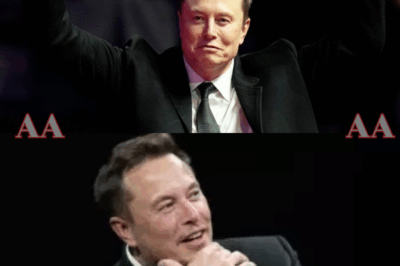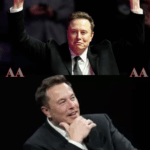Elon Musk, the visionary behind Tesla, SpaceX, and Neuralink, has once again captured the world’s attention with the announcement of his long-rumored electric plane.
Scheduled for a 2026 launch, this futuristic aircraft promises to revolutionize global transport with groundbreaking innovations that could redefine the aviation industry.
Musk’s bold move, which combines Tesla’s expertise in electric propulsion with cutting-edge aerospace engineering, has already left competitors scrambling to catch up.
Experts say this could be the pivotal moment that shifts the future of sustainable air travel.

A Visionary Leap into Electric Aviation
For years, Musk has hinted at Tesla’s potential entry into the aviation sector.
While Tesla has dominated the electric vehicle market and SpaceX has set new standards for reusable rockets, the idea of an electric plane has always been viewed as an ambitious dream.
Now, that dream is becoming a reality. Musk’s vision for the electric plane is not just about creating an environmentally friendly alternative to traditional aircraft—it’s about transforming how we think about air travel altogether.
The electric plane, tentatively named the “Tesla SkyJet,” is designed to merge the luxury and speed of private jets with the efficiency and accessibility of everyday travel.
Musk envisions a world where passengers can skip airport lines, take off from rooftops, and silently soar across cities and countries without burning a single drop of fuel.
This bold concept could make air travel more sustainable, convenient, and affordable for millions.
Revolutionary Design and Engineering

At the heart of Tesla’s electric plane is its innovative design.
The aircraft features a narrow, aerodynamically tapered fuselage made from carbon fiber-reinforced polymer laminates.
This material reduces structural weight by up to 27% compared to traditional aerospace-grade aluminum, allowing for larger battery installations without compromising performance.
Optimized unidirectional plies in high-stress zones and woven cloth in curved areas provide tensile strengths exceeding 800 megapascals and stiffness between 70 and 120 gigapascals.
The plane’s wings are engineered with blended roots to minimize interference drag, boasting aspect ratios between 9.5 and 10.5.
Winglets designed to sustain laminar flow over more than 45% of the chord length deliver lift-to-drag ratios of 17 to 18—far superior to current designs, which typically achieve ratios of 14 to 15.
This configuration improves cruise efficiency by up to 15% at speeds of 300 kilometers per hour, extending range without requiring larger batteries.
Vertical takeoff and landing (VTOL) capabilities are enabled by six to eight vectored electric ducted fans, each producing between 80 and 120 kilowatts of power.
These fans are enclosed to reduce noise and improve safety, with advanced acoustic tuning keeping noise levels below 65 decibels at a distance of 100 meters—25 decibels quieter than most helicopters.
The motors use permanent magnet synchronous technology with peak efficiencies exceeding 94%, cooled by liquid microchannels to maintain optimal performance during vertical lift operations.
Luxury Meets Efficiency
Tesla’s electric plane is not just about performance—it’s also about redefining comfort and usability in aviation.
The cabin is designed to maximize usable space while maintaining a low center of gravity for improved stability.
A four-seat layout offers ergonomic seating with cushions made from high-density foam, ensuring comfort during long flights.
Seats can recline up to 150 degrees for added luxury, while the cabin interface features an aviation-grade touchscreen for navigation, climate control, and entertainment.
The aircraft also includes thoughtfully designed luggage compartments in the nose and rear, providing a total of 2.1 cubic meters of storage space—enough for four large suitcases and additional items like golf clubs or snowboards.
Noise control is achieved through multi-layer insulation and active vibration dampers, keeping cabin noise below 55 decibels during cruise.
Environmental systems are optimized for both unpressurized flights below 12,000 feet and high-altitude pressurized operations, balancing energy use and weight.
The Sustainability Factor
One of the most significant aspects of Tesla’s electric plane is its commitment to sustainability.
Unlike traditional aircraft that rely on fossil fuels, the Tesla SkyJet is powered entirely by electricity.
Its battery system, built from modular units, can sustain discharge rates of six to eight times its nominal capacity, enabling high-power vertical takeoff and landing without torque drop.
The batteries are expected to last for 1,000 to 3,000 full charge cycles, with modular designs allowing for efficient replacements.
The plane’s propulsion system uses permanent magnet synchronous motors with no moving parts that require oil, reducing wear and tear.
These motors are designed to run for over 10,000 flight hours without major repairs, cutting maintenance costs and downtime.
Additionally, the aircraft’s exterior features a self-repairing polymer coating that fills small scratches automatically, preserving aerodynamic performance and reducing the need for repainting.
Aviation Experts Weigh In
Industry experts believe Tesla’s electric plane could be a game-changer for global transport.
Phil Coupeman, an autonomous vehicle researcher and professor emeritus at Carnegie Mellon University, described the aircraft as “a bold leap forward” that could redefine the aviation industry.
“Tesla’s ability to merge strength, safety, and efficiency without compromise is unmatched,” Coupeman said.
“This is not just an electric plane—it’s a new way of thinking about air travel.”
Bryant Walker Smith, an aviation safety expert at the University of South Carolina, echoed these sentiments.
“Tesla’s innovations in material science, propulsion, and battery technology are setting new benchmarks for the industry,” Smith said.
“If Musk can deliver on this vision, the Tesla SkyJet could become the standard for sustainable aviation.”
Challenges and Opportunities
Despite the excitement surrounding Tesla’s electric plane, challenges remain.
The aircraft’s range, currently estimated at 300 miles per charge, may limit its use for long-haul flights.
Advances in battery technology will be crucial to extending range and improving energy density.
Additionally, regulatory hurdles and certification processes could delay the plane’s entry into the market.
However, the opportunities are immense.
The Tesla SkyJet could disrupt the private jet market, attract environmentally conscious travelers, and pave the way for urban air mobility solutions.
Its VTOL capabilities make it ideal for congested cities, offering a practical alternative to traditional ground transport.
The Future of Air Travel
Elon Musk’s electric plane represents more than just a technological breakthrough—it’s a vision for the future of air travel.
By combining luxury, efficiency, and sustainability, the Tesla SkyJet has the potential to transform how we move across cities, countries, and continents.
As the aviation industry grapples with the challenges of climate change and rising fuel costs, Tesla’s bold move could set a new standard for innovation and environmental stewardship.
With the 2026 launch on the horizon, all eyes are on Musk and Tesla.
If the Tesla SkyJet lives up to its promises, it could redefine the aviation industry and inspire a new era of sustainable transport. Competitors will need to innovate quickly to keep pace, but for now, Tesla is leading the charge into the skies.
News
🚨 BREAKING: Just minutes ago, Elon Musk stunned the sports world by announcing he has officially purchased the Dallas Cowboys for a jaw-dropping $7.5 billion 🏈💰. In a shocking twist, longtime owner Jerry Jones revealed he will be stepping away — and even leaving the United States — after cashing out in what may be the most dramatic move in NFL history. Musk, already the mastermind behind Tesla and SpaceX, now adds “NFL franchise owner” to his empire. Fans are divided: some are hopeful that Musk’s bold vision could rescue the Cowboys from years of inconsistency, while others fear the billionaire’s experimental style could turn “America’s Team” into a risky venture. No matter which side you’re on, one thing is certain: the Cowboys will never be the same again. The future of the NFL just changed in real time — and the world is watching|KF
7 MINUTES AGO: Elon Musk Buys the Dallas Cowboys for $7.5 Billion — Jerry Jones Leaves America The sports world…
💥 “DISNEY CUT HIM. AGAIN. JIMMY KIMMEL’S RESPONSE? A CBS MEGA-DEAL, AN ON-AIR MIC DROP, AND A PROMISE THAT SHOOK THE INDUSTRY TO ITS CORE 💣🎤” The stage went dark. The audience held its breath. Then Jimmy Kimmel, no longer tied down by Disney’s restrictions, delivered a line so sharp it split the late-night world in two. Cameras rolled, jaws dropped, and by the end of his fiery outburst, one truth was clear: this wasn’t the end — it was a revolution. Insiders reveal CBS wasted no time, securing Kimmel in a mega-deal that has already sent rival networks scrambling. Rumors swirl of a “first show” unlike anything TV has ever seen — cryptic, daring, and set to dismantle the old rules of late-night. Executives are panicking, fans are buzzing, and competitors are wondering whose chair will be pulled out next. Jimmy didn’t just survive being cut. He turned rejection into a weapon — and now, the entire industry is bracing for impact. 🔥 The question isn’t whether late-night will change. It’s who will survive the new era Jimmy just ignited|KF
“Disney & ABC can kiss my ass!” That was Jimmy Kimmel’s explosive declaration after being fired — again — from ABC,…
🔥🚀 ELON MUSK SHATTERS ALL RECORDS — Forbes CONFIRMS He’s Now the First Human in History Worth $500 BILLION 💰⚡ From launching rockets into space to reshaping the future of transportation, Elon Musk has never played small. But this time, he’s crossed a line no one thought possible — becoming the first person on Earth to officially reach a staggering $500 billion net worth. 🌍 Fans call it proof of genius. Critics call it proof of greed. Either way, Musk’s meteoric rise is rewriting the rules of money, power, and influence. With Tesla, SpaceX, and xAI all fueling his empire, the question isn’t how high he can go — it’s whether anyone can ever catch up. But behind the headlines lies a bigger debate: Should so much wealth be concentrated in one man’s hands? And what does Musk plan to do with it — save humanity or dominate it? 👉 The story isn’t just about money. It’s about ambition, control, and the thin line between vision and obsession. The world is watching… and the countdown has only just begun|KF|KF
Synopsis Elon Musk’s net worth surged to $500 billion, making him the first person in history to reach this milestone….
💥 “$50 MILLION LAWSUIT SHOCKER — John Roberts Takes Jimmy Kimmel to Court After Explosive On-Air Meltdown” 💥 What started as a seemingly harmless late-night segment has spiraled into one of the biggest media scandals of the year. In front of millions of viewers, Jimmy Kimmel blindsided television veteran John Roberts with a brutal attack — calling out his integrity, his work, and the very system he represents. The audience gasped, the cameras kept rolling, and the fallout has been nothing short of explosive. Now, Roberts is striking back with a massive $50 million lawsuit, accusing Kimmel of defamation and on-air assault that went far beyond comedy. Industry insiders say this case could reshape how late-night television handles interviews, pushing the boundaries between satire and slander. Fans are divided: some call Kimmel’s outburst “necessary truth-telling,” while others brand it reckless and cruel. Roberts, however, has made it clear — he’s not just defending his name, he’s defending the principles of journalism itself. 🔥 The courtroom battle is set to be as dramatic as the clash that started it all — and the world is watching every move|KF
What began as a routine late-night interview quickly spiraled into one of the most shocking confrontations in television history. Jimmy Kimmel went…
End of content
No more pages to load












